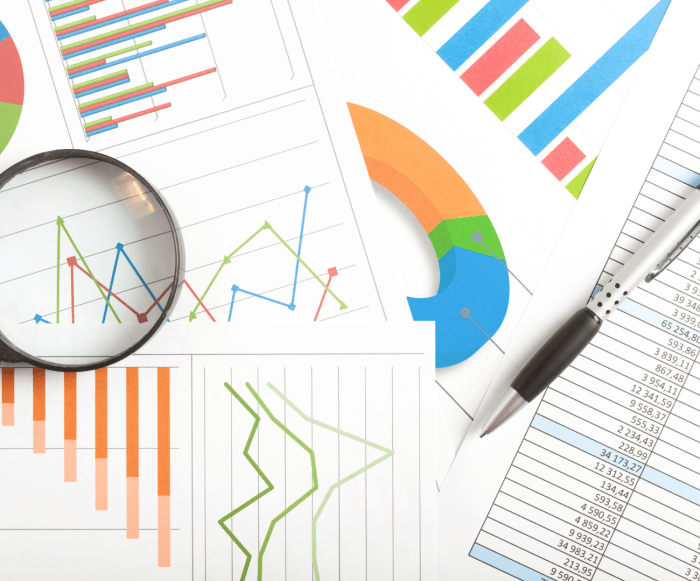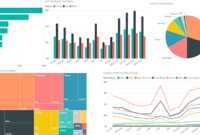Kicking off with Business reporting tools, this opening paragraph is designed to captivate and engage the readers, setting the tone ahrefs author style that unfolds with each word. Business reporting tools play a crucial role in modern businesses, providing valuable insights for informed decision-making and strategic planning. From analyzing financial data to monitoring key performance indicators, these tools are essential for maximizing operational efficiency and staying ahead in today’s competitive market.
As companies continue to rely on data-driven strategies, the importance of leveraging business reporting tools cannot be overstated. In this comprehensive guide, we will explore the various aspects of business reporting tools, from their common features to implementation strategies and the benefits they offer to organizations of all sizes.
Overview of Business Reporting Tools

Business reporting tools play a crucial role in a corporate environment by helping organizations analyze data and make informed decisions. These tools are essential for extracting valuable insights from various sources of data and presenting it in a clear and actionable format.
Purpose of Business Reporting Tools
Business reporting tools are designed to streamline the process of data analysis and reporting within an organization. By utilizing these tools, businesses can track key performance indicators, monitor trends, and identify areas for improvement. This ultimately leads to more informed decision-making and better strategic planning.
Types of Data Analyzed
- Financial Data: Business reporting tools can analyze financial data such as revenue, expenses, and profitability to provide insights into the financial health of the organization.
- Operational Data: These tools can also analyze operational data related to production, inventory, and supply chain management to optimize processes and improve efficiency.
- Customer Data: By analyzing customer data such as purchasing behavior and demographics, businesses can enhance customer satisfaction and tailor their marketing strategies accordingly.
- Market Data: Business reporting tools can help analyze market trends, competitor performance, and industry benchmarks to stay competitive and identify growth opportunities.
Common Features of Business Reporting Tools
Business reporting tools come with a variety of features that help businesses analyze data and generate insightful reports to make informed decisions. These features are essential for streamlining the reporting process and extracting valuable insights from data. Let’s explore some common features found in business reporting tools and how they contribute to the generation of meaningful reports.
Data Visualization Capabilities
Data visualization capabilities allow users to represent complex data in a visually appealing format such as charts, graphs, and dashboards. This feature helps in presenting data trends, patterns, and outliers in a clear and easily understandable manner, enabling stakeholders to interpret data quickly and make informed decisions.
Customizable Reporting Templates, Business reporting tools
Customizable reporting templates enable users to create reports tailored to their specific needs and requirements. This feature allows for the customization of report formats, layouts, and content, ensuring that reports are relevant and address the key metrics and KPIs that matter most to the business.
Real-Time Data Updates
Business reporting tools with real-time data updates provide users with the most up-to-date information, allowing for timely decision-making and monitoring of key performance indicators. This feature ensures that reports reflect the latest data and insights, empowering users to act swiftly based on current information.
Collaboration and Sharing Capabilities
Collaboration and sharing capabilities enable multiple users to collaborate on reports, share insights, and work together on data analysis. This feature promotes teamwork and facilitates knowledge sharing within the organization, leading to better decision-making and a more cohesive approach to data analysis.
Advanced Analytics and Forecasting
Some business reporting tools offer advanced analytics and forecasting capabilities, allowing users to perform in-depth analysis, predictive modeling, and scenario planning. This feature helps businesses anticipate future trends, identify potential risks and opportunities, and make data-driven forecasts to support strategic decision-making.
Mobile Accessibility
Mobile accessibility is a key feature that allows users to access and interact with reports on-the-go from their mobile devices. This feature ensures that stakeholders can stay informed and make decisions anytime, anywhere, without being tied to a desktop computer, increasing flexibility and efficiency in data analysis and reporting.
Implementing Business Reporting Tools
Implementing business reporting tools within an organization is a crucial process that requires careful planning and execution. Here are the steps involved in successfully integrating these tools, along with examples of successful strategies and how to overcome challenges.
Develop a Clear Implementation Plan
- Assess the organization’s reporting needs and objectives to determine the most suitable tools to implement.
- Identify key stakeholders and involve them in the decision-making process to ensure buy-in and support.
- Set clear goals and timelines for the implementation process to track progress effectively.
- Allocate resources and budget accordingly to support the implementation of the reporting tools.
Select the Right Business Reporting Tools
- Research and evaluate different reporting tools in the market to choose the one that best aligns with the organization’s needs and goals.
- Consider factors such as scalability, ease of use, integration capabilities, and cost when selecting the tools.
- Ensure compatibility with existing systems and processes to facilitate a smooth transition and minimize disruptions.
- Provide adequate training and support for employees to effectively utilize the chosen reporting tools.
Integrate the Reporting Tools into Existing Systems
- Collaborate with IT and data teams to integrate the reporting tools with existing systems and databases seamlessly.
- Ensure data accuracy and consistency by mapping out data sources and establishing data governance protocols.
- Create standardized report templates and formats to maintain uniformity and ease of interpretation across the organization.
- Test the integration thoroughly to identify and resolve any issues before full deployment.
Monitor and Evaluate Performance
- Track key performance indicators (KPIs) to measure the impact of the reporting tools on the organization’s efficiency and decision-making processes.
- Gather feedback from users to identify areas for improvement and optimization of the reporting tools.
- Regularly review and update the reporting tools to ensure they remain aligned with the organization’s evolving needs and goals.
- Continuously train and educate employees on using the reporting tools effectively to maximize their benefits.
Benefits of Using Business Reporting Tools

Business reporting tools offer numerous advantages for data analysis and decision-making within organizations. These tools can help improve operational efficiency, enhance strategic planning, and provide valuable insights for informed decision-making. Let’s delve into the specific benefits of utilizing business reporting tools:
Enhanced Data Analysis
- Business reporting tools allow for in-depth data analysis, enabling organizations to identify trends, patterns, and correlations within their data sets.
- By utilizing advanced analytics features, businesses can gain valuable insights into customer behavior, market trends, and operational performance.
- These insights can help organizations make data-driven decisions, optimize processes, and improve overall performance.
Improved Operational Efficiency
- Business reporting tools streamline the data collection and reporting process, saving time and resources for organizations.
- Automated reporting features can generate real-time reports, dashboards, and visualizations, providing stakeholders with up-to-date information for quick decision-making.
- By centralizing data sources and standardizing reporting formats, these tools enhance collaboration, communication, and efficiency across departments.
Real-World Scenarios
- A retail company implemented a business reporting tool to analyze sales data and customer preferences. By identifying top-selling products and consumer trends, the company optimized its inventory management and marketing strategies, leading to increased sales and customer satisfaction.
- A financial institution utilized reporting tools to monitor and analyze transaction data for fraud detection. By implementing real-time alerts and predictive analytics, the institution was able to prevent fraudulent activities and safeguard its customers’ assets.
- An e-commerce platform leveraged business reporting tools to track website traffic, user engagement, and conversion rates. By analyzing this data, the platform optimized its marketing campaigns, improved website usability, and increased sales revenue.
Trends in Business Reporting Tools

AI and machine learning are revolutionizing the field of business reporting tools, enabling companies to extract valuable insights from their data like never before. These technologies are driving advancements in automation, predictive analytics, and data visualization, shaping the future of reporting tools.
Impact of AI and Machine Learning
AI and machine learning algorithms are being integrated into business reporting tools to automate data processing, analyze trends, and generate accurate forecasts. These technologies can identify patterns in large datasets, detect anomalies, and provide actionable insights in real-time. By leveraging AI and machine learning, organizations can make data-driven decisions faster and more effectively.
- Automated Data Processing: AI-powered reporting tools can automate the collection, cleansing, and processing of data, saving time and reducing errors.
- Predictive Analytics: Machine learning algorithms can forecast future trends based on historical data, enabling businesses to anticipate market changes and make proactive decisions.
- Data Visualization: AI-driven tools can create interactive dashboards and visualizations that simplify complex data sets, making it easier for users to understand and interpret information.
Future Trends in Reporting Tools
Looking ahead, we can expect to see further advancements in natural language processing (NLP) for generating reports, augmented analytics for enhanced data discovery, and the integration of blockchain technology for secure data sharing. As the demand for real-time insights continues to grow, reporting tools will evolve to provide more dynamic and customizable features, empowering businesses to stay ahead in today’s competitive landscape.
In conclusion, Business reporting tools are indispensable for companies looking to thrive in a data-driven landscape. By harnessing the power of these tools, businesses can gain valuable insights, optimize their operations, and make well-informed decisions that drive growth and success. Stay ahead of the curve by embracing the world of business reporting tools and unlock new possibilities for your organization.
Interactive BI reports play a crucial role in Enhancing Data Insights with Interactivity. By allowing users to interact with the data, businesses can uncover valuable trends and patterns that may have otherwise gone unnoticed. This level of engagement leads to more informed decision-making and ultimately, a competitive edge in the market. Learn more about the benefits of Interactive BI reports here.
Data Insights are essential for Uncovering the Power of Data for Business Success. With the right tools and strategies, businesses can extract valuable information from their data to drive growth and innovation. By leveraging data insights effectively, companies can stay ahead of the curve and make informed decisions that drive success. Discover more about the impact of Data Insights here.
Big data analytics is the key to Unleashing the Power of Data Insights. By harnessing the vast amounts of data available, businesses can gain valuable insights that drive strategic decision-making and improve overall performance. With the right analytics tools and techniques, companies can unlock the full potential of their data and stay ahead in today’s competitive landscape. Find out more about the power of Big data analytics here.




